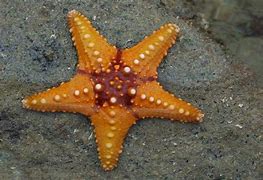
Starfish
Starfish, also known as sea stars, are intriguing marine invertebrates belonging to the class Asteroidea. They are found in various marine environments worldwide, from shallow coastal waters to the deep sea. Here are some interesting facts about starfish:
Radial Symmetry: Starfish have a distinctive body structure characterized by radial symmetry. They typically have five arms, although some species can have more arms. The arms radiate outwards from a central disc, giving them their star-like appearance. However, not all starfish have five arms; some species have fewer or more arms.
Regeneration Abilities: Starfish possess remarkable regenerative capabilities. If they lose an arm or part of their central disc, they can regenerate the lost body parts, including the entire organism in some cases. This ability is due to their decentralized nervous system and the presence of specialized cells called neoblasts, which can differentiate into different cell types.
Water Vascular System: Starfish have a unique water vascular system that helps them with locomotion and feeding. It consists of a network of fluid-filled canals connected to tube feet. By controlling the water pressure within the canals, starfish can extend or retract their tube feet, allowing them to move, grasp prey, and adhere to surfaces.
Feeding Habits: Starfish are opportunistic feeders and have a diverse diet. Some species are predators that feed on mollusks, crustaceans, and other invertebrates. They can pry open shells or use their tube feet to grab and manipulate their prey. Other starfish species are detritivores, scavenging on organic matter and decaying organisms on the seafloor.
Predation Techniques: Some starfish have unique predation techniques. For example, the crown-of-thorns starfish has numerous venomous spines and can feed on coral polyps, posing a threat to coral reefs. The sunflower starfish is a voracious predator that can engulf and digest large prey, such as bivalve mollusks.
Tube Feet Sensory Abilities: Starfish use their tube feet not only for movement but also to sense their environment. Their tube feet are equipped with sensory cells that allow them to detect light, chemicals, and even low-frequency vibrations. This sensory information helps them locate prey, avoid predators, and navigate their surroundings.
Reproduction: Starfish exhibit a range of reproductive strategies. While most species are dioecious, meaning they have separate male and female individuals, some species are hermaphroditic, possessing both male and female reproductive organs. They can reproduce sexually by releasing eggs and sperm into the water for external fertilization. Some species are also capable of asexual reproduction through fragmentation or by self-fertilizing their eggs.
Importance in Ecosystems: Starfish play important ecological roles in marine ecosystems. As predators, they help regulate the populations of other invertebrates, maintaining a balance in the food web. Additionally, their movements and feeding behaviors can influence the distribution and abundance of species on the seafloor.
Diversity of Species: There are thousands of species of starfish, ranging in size, color, and morphology. They can be found in a wide range of habitats, including intertidal zones, rocky shores, coral reefs, seagrass beds, and deep-sea environments. Some species, like the crown-of-thorns starfish and the blue starfish, are well-known and visually striking.
Conservation Status: Some starfish populations face threats due to habitat destruction, pollution, climate change, and overharvesting. For example, the global population of the coral-eating crown-of-thorns starfish has caused concerns for coral reef conservation efforts. It is important to protect their habitats and implement sustainable practices to ensure the survival of these fascinating creatures.